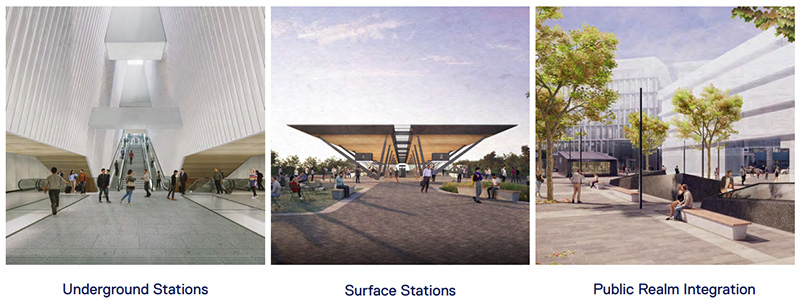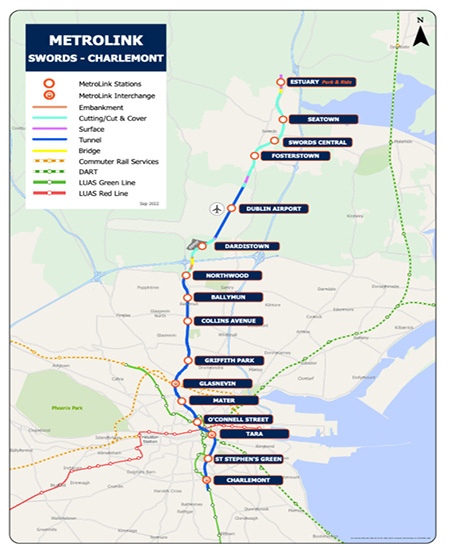Dublin MetroLink $12.6B Rail Project Approved, Procurement to Begin in 2026

Ireland has finally cleared the way for its largest-ever transportation investment, granting a Railway Order on Oct. 2 that authorizes construction of the $12.6-billion Dublin MetroLink.
The order, issued by An Coimisiún Pleanála, serves as Ireland’s statutory approval body for rail projects, giving Transport Infrastructure Ireland legal authority to build and operate the line.
The 18.8-km driverless metro will connect Dublin Airport and the fast-growing suburb of Swords, north of the airport, to the city center and Charlemont, south of the central business district.
With 16 stations—11 underground—the line will tunnel beneath the River Liffey to link airport traffic, commuter suburbs and Dublin’s core business district.
According to Transport Infrastructure Ireland. the fully automated system is designed to move up to 30 trains per hour at peak, carrying hundreds of thousands of passengers daily. At an estimated $670 million per kilometer, MetroLink’s cost rivals New York City’s Second Avenue Subway and places it among Europe’s largest ongoing megaprojects, alongside the UK’s High Speed 2 rail line.
DeR Renderings show concepts for Dublin MetroLink underground and surface stations, along with integration into surrounding public spaces. Image courtesy of Transport Infrastructure Ireland. Map courtesy of Transport Infrastructure Ireland
The approval allows Transport Infrastructure Ireland to move from planning to procurement, with enabling works scheduled to begin in 2026. Project filings state the alignment will be driven by two tunnel boring machines excavating through glacial tills and underlying alluvial soils, with bored sections reaching depths of 30 meters.
 Route map of Dublin’s planned MetroLink, a $12.6-billion automated rail line running 18.8 km from northern suburb Swords through Dublin Airport to southern suburb Charlemont, with 16 stations and connections to commuter rail and to LUAS light rail lines. Map courtesy of Transport Infrastructure Ireland
Route map of Dublin’s planned MetroLink, a $12.6-billion automated rail line running 18.8 km from northern suburb Swords through Dublin Airport to southern suburb Charlemont, with 16 stations and connections to commuter rail and to LUAS light rail lines. Map courtesy of Transport Infrastructure Ireland
The project Environmental Impact Assessment Report, reviewed by ENR, specifies cut-and-cover construction at O’Connell Street and St. Stephen’s Green, where deep station boxes will be built adjacent to heritage structures.
Settlement, vibration and groundwater monitoring are required throughout construction, with mitigation measures to protect historic buildings, utilities and surface transport corridors. Advance contracts will divert major utilities, conduct archaeological investigations and stabilize heritage assets before the tunnel drives begin.
Transport Infrastructure Ireland has assembled a team led by Turner & Townsend and WSP to oversee procurement and program delivery, supported by additional Irish and international consultants. AtkinsRealis has been appointed to design advance works, while IDOM and Jacobs produced engineering studies for tunnels, stations and railway systems.
Procurement of the main civil works will be delivered in packages. According to public records, no general contractor has been publicly named; however, Transport Infrastructure Ireland has indicated that tendering for core construction contracts will begin in 2026.
International players are already signaling interest. In September, Alstom announced it had signed a memorandum of understanding with FCC, John Laing, Meridiam and RATP Dev to bid on a design-build-finance-operate-maintain package.
Ireland’s Department of Transport called the approval a “nation-building” milestone. “This project will transform how people move around our capital,” Transport Minister Eamon Ryan said in a statement. Airport operator daa, which will receive a dedicated station on the line, said MetroLink would improve access for more than 40 million annual passengers.
With enabling works expected to start next year and major tunneling to follow, Transport Infrastructure Ireland projects MetroLink could open in the early 2030s.
The post "Dublin MetroLink $12.6B Rail Project Approved, Procurement to Begin in 2026" appeared first on Consulting-Specifying Engineer

